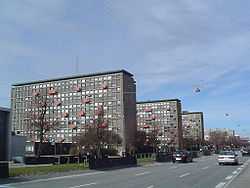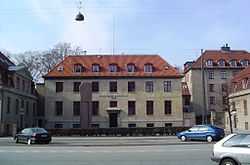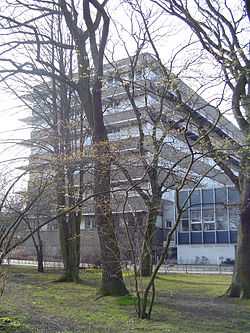University of Copenhagen Faculty of Science
| Faculty of Science | |
|---|---|
| Det Natur- og Biovidenskabelige Fakultet | |
|
| |
| Latin: Facultatis Naturalis | |
| Established | 1850 (as an independent faculty) |
| Type | Public university |
| Dean | John Renner Hansen |
| Students | 6200 |
| Location | Copenhagen, Denmark |
| Affiliations | EUA, LAOTSE |
| Website | science.ku.dk |


The Faculty of Science (Det Natur- og Biovidenskabelige Fakultet in Danish) at the University of Copenhagen consists of both mathematical and natural sciences, and is divided into 11 institutes including the Natural History Museum of Denmark. Some institutes are in turn divided into a number of sections and laboratories, and the faculty also encompasses several national and international research centres, and has a number of field stations in Denmark and in Greenland, among them the Arctic Station in central West Greenland.
All institutes are situated in the central part of Copenhagen. The fine old building of the former Astronomical Observatory - 3 Øster Voldgade - now houses the Faculty Administration.
The Faculty of Science is a big and living work place. The faculty has a permanent staff of 1200 people inclusive academic tenures and technical or administrative personnel. Additionally a large number of temporary staff works at the faculty financed by external grants and contracts.
The Faculty of Science offers a three-year Bachelor of Science degree (BS), a two-year Master of Science degree (MS) and a three-year Ph.D. degree. There are two main areas of study programmes. One is the mathematical-physical-chemical subject group, which includes mathematics, computer science, actuarial science, mathematical economy, statistics, physics, astronomy, geophysics, meteorology, biophysics, chemistry, environmental chemistry, biochemistry and nano-science. The other is the natural history-geography group, which includes biology, sports science, geology, geography, geo-informatics, geology-geophysics and bio-informatics. From September 2003 the Faculty of Science additionally offers 2 one-year master programmes, one in Geography and one in Physical Education and Sports Science.
In 2002 the faculty had a total of 6200 ordinary students enrolled together with a large number of guest students from universities abroad or other institutions in Denmark. The number of students in each programme varies significantly, whereas 1350 students are enrolled in the Biology programme, a total of 124 students is enrolled in the Actuarial Mathematics programme.
The seal
The seal of the faculty contains the following text
|
|
which is written in a circle around a stilized rendering of a hafnium atom. Hafnium was discovered at the Faculty in 1923 by Dirk Coster and Georg von Hevesy, and the name of the element is derived from Hafnia which is the Latin name for Copenhagen.
Departments under The Faculty of Science
- Department of Biology
- Department of Chemistry
- Department of Computer Science
- University of Copenhagen Department of Geography & Geology
- Institute for Mathematical Sciences
- Institute of Molecular Biology and Physiology
- Niels Bohr Institute for Astronomy, Physics and Geophysics
- Institute of Exercise and Sport Sciences
- Department of Science Education
- Natural History Museum of Denmark
- Bioinformatics Centre
- Center for the Philosophy of Nature and Science Studies (CPNSS)
- Center for Planetary Research
- Center for Social Evolution and Symbiosis
- COGCI - Copenhagen Global Change Initiative
- Danish Archaea Centre (DAC)
- Nano-Science Center
- Natural Sciences IT Competence Center
On January 1, 2004, the Botanical Institute and Zoological Institute merged as Department of Biology, while the four museums Botanical Garden, Botanical Museum and Library, Geological Museum and Zoological Museum merged as Natural History Museum of Denmark.
On January 1, 2005, the August Krogh Institute and the Department of Molecular Biology merged as Department of Molecular Biology and Physiology.
On January 1, 2008, the Department of Biology and the Department of Molecular Biology and Physiology merged as a reconstructed Department of Biology.
External links
Coordinates: 55°41′51″N 12°33′34″E / 55.69750°N 12.55944°E

